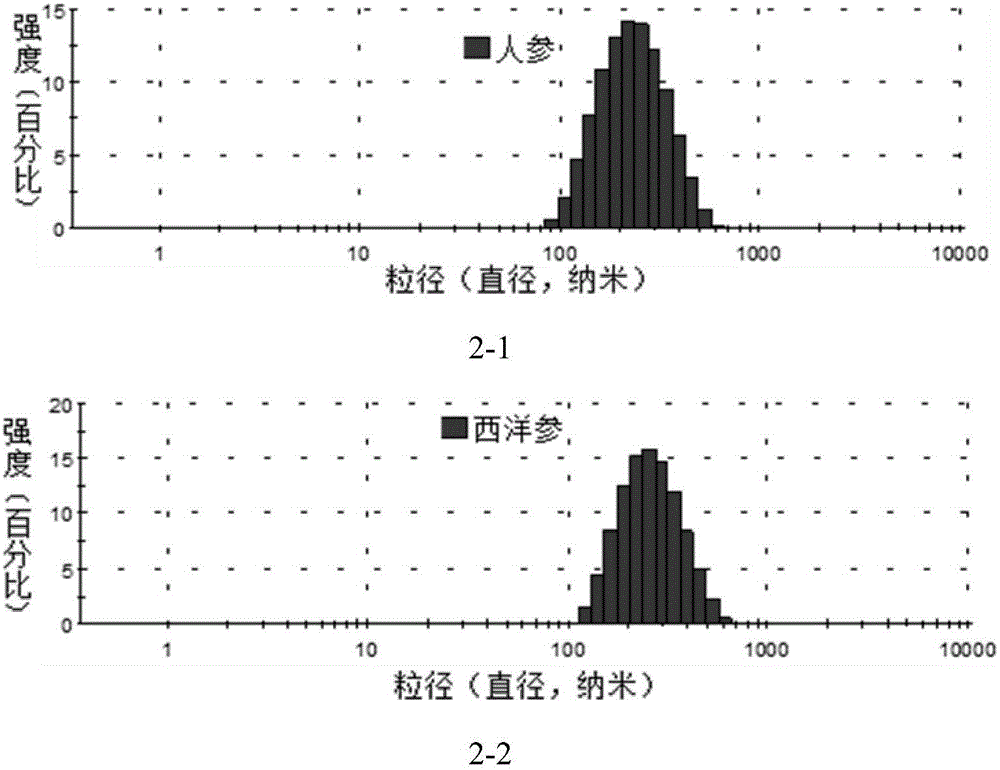Ginseng derived nano-particles, as well as preparation and application thereof
A nanoparticle and ginseng technology, applied in the field of immune enhancers, can solve the problems of inability to activate immune molecules and inability to fully promote cell-mediated immune responses, and achieve good application prospects, easy operation, and less time-consuming effects
- Summary
- Abstract
- Description
- Claims
- Application Information
AI Technical Summary
Problems solved by technology
Method used
Image
Examples
Embodiment 1
[0037] Example 1: Preparation of ginseng-derived nanoparticles
[0038] (1) Wash fresh ginseng with clean water, and extract the original pulp through low-speed screw extrusion technology in an environment of 20°C;
[0039] (2) filtering the squeezed raw pulp through a 500-mesh sieve in an environment of 20°C to remove impurities, and collecting the filtrate;
[0040] (3) Centrifuge the collected filtrate at 200×g for 10 minutes, discard the precipitate, and collect the supernatant; then centrifuge the supernatant at 2000×g for 30 minutes, discard the precipitate, and collect the supernatant; Centrifuge at 10,000×g for 60 minutes, discard the precipitate, and collect the supernatant; finally, centrifuge the supernatant at 120,000×g for 60 minutes, and collect the precipitate;
[0041] (4) After the precipitate was resuspended with pH 7.2 phosphate buffer, centrifuge at 120,000×g for 60 minutes to collect the precipitate; , centrifuged for 60 minutes, and the supernatant was ...
Embodiment 2
[0042] Example 2: Preparation of nanoparticles derived from American ginseng
[0043] (1) Wash the fresh American ginseng with clean water, and extract the original pulp by low-speed screw extrusion technology in an environment of 10°C;
[0044] (2) filter the extracted raw pulp through a 200-mesh sieve in an environment of 10°C to remove impurities, and collect the filtrate;
[0045] (3) Centrifuge the collected filtrate at 500×g for 5 minutes, discard the precipitate, and collect the supernatant; then centrifuge the supernatant at 5000×g for 10 minutes, discard the precipitate, and collect the supernatant; Centrifuge at 12,000×g for 30 minutes, discard the precipitate, and collect the supernatant; finally, centrifuge the supernatant at 100,000×g for 90 minutes, and collect the precipitate;
[0046] (4) After the precipitate was resuspended with pH 7.4 phosphate buffer, centrifuge at 100,000×g for 90 minutes to collect the precipitate; , centrifuged for 30 minutes, and the su...
Embodiment 3
[0047] Example 3: Preparation of nanoparticles derived from Panax notoginseng
[0048] (1) Wash the fresh Panax notoginseng with clean water, and extract the original pulp by low-speed screw extrusion technology in an environment of 25°C;
[0049] (2) Filtrating the squeezed raw pulp through a 1000-mesh sieve in an environment of 25°C to remove impurities, and collecting the filtrate;
[0050] (3) Centrifuge the collected filtrate at 500×g for 10 minutes, discard the precipitate, and collect the supernatant; then centrifuge the supernatant at 5000×g for 30 minutes, discard the precipitate, and collect the supernatant; Centrifuge at 12,000×g for 45 minutes, discard the precipitate, and collect the supernatant; finally, centrifuge the supernatant at 200,000×g for 60 minutes, and collect the precipitate;
[0051] (4) After the precipitate was resuspended with pH 7.3 phosphate buffer, centrifuge at 200,000×g for 60 minutes to collect the precipitate; , centrifuged for 45 minutes...
PUM
| Property | Measurement | Unit |
|---|---|---|
| Particle size | aaaaa | aaaaa |
| Peak particle size | aaaaa | aaaaa |
| Aperture | aaaaa | aaaaa |
Abstract
Description
Claims
Application Information
 Login to View More
Login to View More - R&D Engineer
- R&D Manager
- IP Professional
- Industry Leading Data Capabilities
- Powerful AI technology
- Patent DNA Extraction
Browse by: Latest US Patents, China's latest patents, Technical Efficacy Thesaurus, Application Domain, Technology Topic, Popular Technical Reports.
© 2024 PatSnap. All rights reserved.Legal|Privacy policy|Modern Slavery Act Transparency Statement|Sitemap|About US| Contact US: help@patsnap.com










